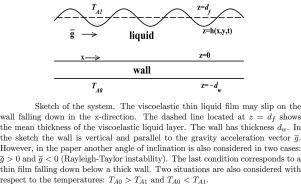Thermocapillary stability of a viscoelastic liquid film falling down above or below an inclined thick wall with slip
IF 6.3
3区 工程技术
Q1 ENGINEERING, CHEMICAL
Journal of the Taiwan Institute of Chemical Engineers
Pub Date : 2024-10-03
DOI:10.1016/j.jtice.2024.105788
引用次数: 0
Abstract
Background:
Thin viscoelastic liquid films falling down walls have been investigated theoretically since many years ago due to their applications in coating and cooling of substrates. They may also be subjected to temperature gradients and have been investigated under a variety of boundary conditions. In particular, the Navier slip boundary condition has been the subject of recent research. This condition is used when at the interface between the liquid and the wall the no-slip boundary condition does not apply due to different reasons like wall small topography, chemical coatings, etc.
Methods:
The small wavenumber approximation is used to derive a nonlinear evolution equation to describe the free surface deformations of the viscoelastic liquid film falling down an inclined wall. This equation is linearized and its linear stability is investigated using normal modes. The nonlinear free surface deformations are calculated numerically by means of a normal modes expansion substituted into the nonlinear evolution equation.
Significant Findings:
The thermocapillary stability of a thin viscoelastic film falling down a thick wall of finite thermal conductivity is investigated. Linear and nonlinear flows are examined when the interface of the liquid and the wall presents slip effects. The stability of the flow above and below (Rayleigh–Taylor) the wall is also explored. The lubrication approximation is used to derive a nonlinear evolution equation for the free surface deformation. The curves of linear growth rate, maximum growth rate and critical Marangoni number are calculated for different viscoelastic Deborah numbers. The film will be subjected to destabilizing and stabilizing Marangoni numbers. It is found that from the point of view of the linear growth rate the flow destabilizes with slip in a wavenumber range . However slip stabilizes for larger wavenumbers up to the critical (cutoff) wavenumber. The results show that the Deborah number displaces to the right. When reaches the critical wavenumber by an increase of the Deborah number, slip is unable to stabilize. The corresponding critical Deborah number is derived. On the contrary, when the Deborah number is zero these slip stabilizing regions correspond to Newtonian fluids investigated in previous works. From the point of view of the maximum growth rate slip may stabilize or destabilize increasing the slip parameter depending on the magnitude of the Marangoni, Galilei and Deborah numbers. Explicit formulas were derived for the intersections where slip may change its stability properties. Numerical solutions of the free surface nonlinear evolution equation show that slip can decrease the amplitude and may stimulate the appearance of subharmonics. The effects of different wall properties are also investigated.

粘弹性液膜在带滑移的倾斜厚壁上方或下方下落时的热毛细管稳定性
背景:由于薄粘弹性液膜在基底涂层和冷却方面的应用,人们从多年前就开始从理论上对其进行研究。它们也可能会受到温度梯度的影响,并在各种边界条件下进行了研究。其中,纳维滑移边界条件是近期研究的主题。当液体和墙壁之间的界面由于不同原因(如墙壁小地形、化学涂层等)不适用无滑移边界条件时,就会使用这种条件。方法:使用小波数近似推导出非线性演化方程,以描述粘弹性液膜从倾斜墙壁上落下时的自由表面变形。对该方程进行了线性化处理,并利用法向模态对其线性稳定性进行了研究。重要发现:研究了粘弹性薄膜沿有限热导率的厚壁下落时的热毛细管稳定性。当液体和壁的界面出现滑移效应时,研究了线性和非线性流动。此外,还探讨了壁面上方和下方(瑞利-泰勒)流动的稳定性。利用润滑近似推导出自由表面变形的非线性演化方程。计算了不同粘弹性 Deborah 数的线性增长率、最大增长率和临界马兰戈尼数曲线。薄膜将受到失稳和稳定马兰戈尼数的影响。结果发现,从线性增长率的角度来看,在波数范围 k < k+ 内,流动会随着滑移而失稳。然而,在较大的波数 k > k+ 直至临界(截止)波数范围内,滑移会趋于稳定。结果表明,德博拉数会使 k+ 向右移动。当 k+ 通过增加德博拉数达到临界波数时,滑移无法稳定。相应的临界德博拉数也由此得出。相反,当德博拉数为零时,这些滑移稳定区域 k > k+ 与之前研究的牛顿流体相对应。从最大增长率的角度来看,滑移可能稳定,也可能不稳定,这取决于马兰戈尼数、伽利略数和狄波拉数的大小。对于滑移可能改变其稳定性能的交叉点,推导出了明确的公式。自由表面非线性演化方程的数值解表明,滑移会降低振幅,并可能刺激次谐波的出现。此外,还研究了不同壁面特性的影响。
本文章由计算机程序翻译,如有差异,请以英文原文为准。
求助全文
约1分钟内获得全文
求助全文
来源期刊
CiteScore
9.10
自引率
14.00%
发文量
362
审稿时长
35 days
期刊介绍:
Journal of the Taiwan Institute of Chemical Engineers (formerly known as Journal of the Chinese Institute of Chemical Engineers) publishes original works, from fundamental principles to practical applications, in the broad field of chemical engineering with special focus on three aspects: Chemical and Biomolecular Science and Technology, Energy and Environmental Science and Technology, and Materials Science and Technology. Authors should choose for their manuscript an appropriate aspect section and a few related classifications when submitting to the journal online.

 求助内容:
求助内容: 应助结果提醒方式:
应助结果提醒方式:


